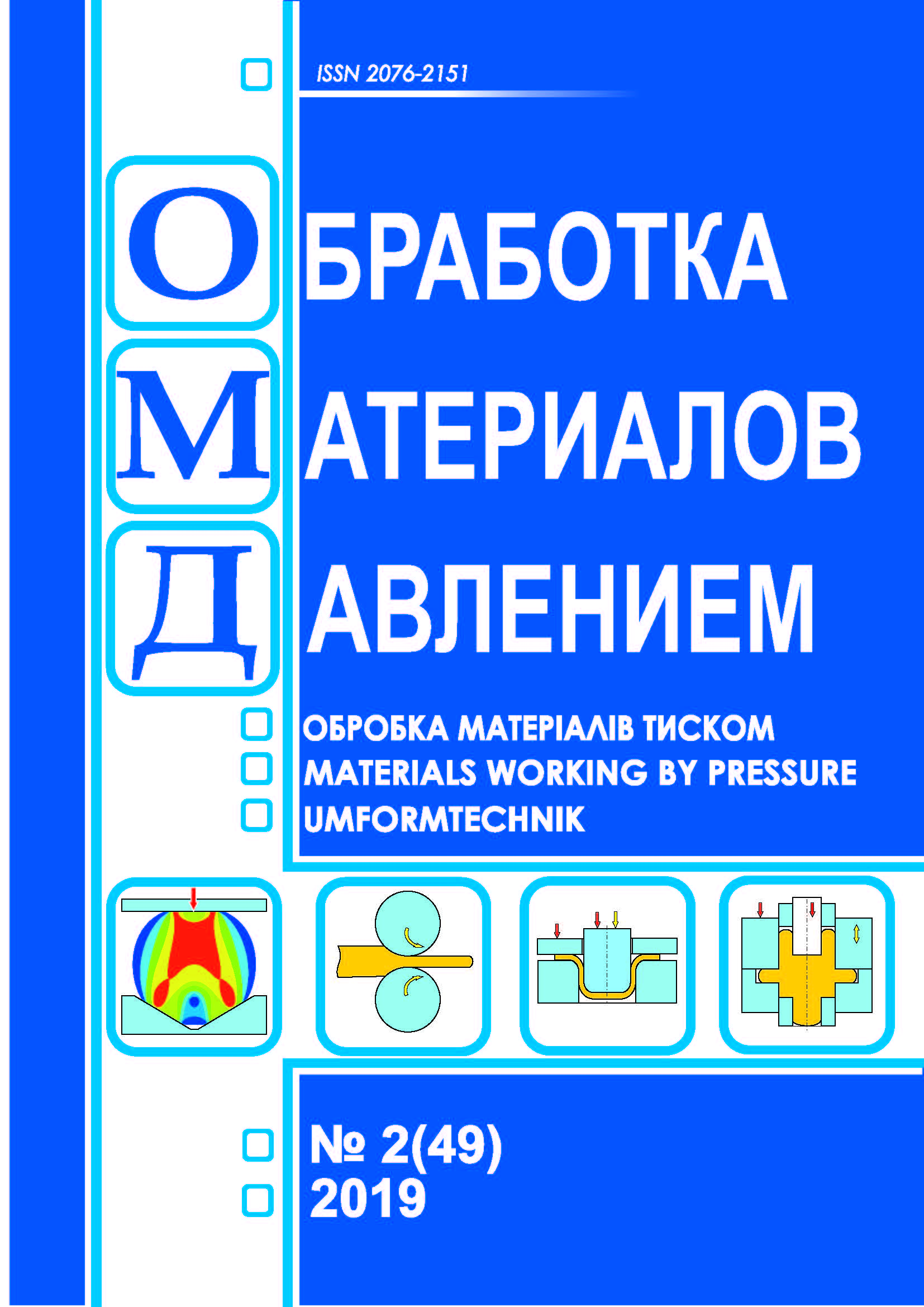Researches of the stress-strain state of hollow parts during combined extrusion with distribution
DOI:
https://doi.org/10.37142/2076-2151/2019-2(49)114Keywords:
radial forward extrusion; hollow parts; deformation forces; finite element method; stress state indicator.Abstract
Aliieva L. I., Kalyuzhnyiy V. L., Kartamyshev D. O., Moiseeva A. M., Sivak R. I. Researches of the stress-strain state of hollow parts during combined extrusion with distribution // Material working by pressure. – 2019. – № 2 (49). - Р. 114-122.
Typical schemes for producing hollow products by means of radial forward extrusion with compression and distribution are considered. The power regime and the stress-strain state (SSS) were modeled by the finite element method in the DEFORM 3D software package for the radial forward extrusion process with distribution. The dependence of the angle of the conical surface of the matrix on the power mode and the distribution of normal stresses in the process of deformation are established. Based on the simulation results, a direct proportional dependence of the maximum normal stresses on the punch on the growth of the angle of the conical surface of the matrix and inversely proportional dependence on the growth of the force on the punch is established. The regularities of the development of SSS in various zones of deformation of the workpiece are established. To characterize the SSS indicators, 5 characteristic points were identified in the deformation zone. It was determined that the zones located near the bottom and the inner surface of the part are subject to the most intense deformation. A significant increase in the strain intensity for points located closer to the inner surface of the part as it is in the deformation zone and stabilization of values after leaving the zone of intense deformation are found. To quantify the changes in the nature of the stress state, the dependence of the stress state index on the strain intensity is constructed. Comparison of the stress state index for various metal particles showed that zones on the peripheral part of the workpiece that undergo nonmonotonic deformation are most susceptible to destruction.
References
Evstratov V.A. Fundamentals of extrusion technology and the design of dies. Kharkov: High school. 1987, 144 p. (in Russian).
Ovchinnikov A.G. Fundamentals of the theory of stamping by extrusion on the press. Moscow: Mechanical Engineering. 1983, 200 p. (in Russian).
Avdeev V.M., Aksenov L.B., Aliiev I.S. et al. The manufacture of blanks and parts by plastic deformation, Eds. Bogojvlensky K.N., Ris V.V. Leningrad: Polytechnic, 1991, 351 p. (in Russian).
Aliiev I.S. Technological capabilities of new methods of combined extrusion. Forging and Stamping Production. 1990, 2, pp. 7–10. (in Russian).
Dmitriev A.M., Vorontsov A.L. Extrusion of hollow products with the distribution of the workpiece in a moving matrix. Bulletin of mechanical engineering. 2004, 10, pp. 55–61. (in Russian).
Renne I.P., Sumarokova A.I. Technological capabilities of the process of free extrusion (without a matrix) of hollow parts. Forging and Stamping Production. 1987, 6, pp. 25–26. (in Russian).
Danilin G.A., Ogorodnikov V.P. Theory and calculations of processes of combined plastic forming. SPb: BSTU. 2004,304 p. (in Russian).
Aliieva L.I. Improving the processes of combined extrusion: monograph. Kramatorsk: Ltd “Tiraj – 51”. 2018, 352 p. (in Russian).
Aliieva L.I. Processes of combined plastic deformation and extrusion. Material Working by Pressure. 2016, 1 (42), pp. 100–108. (in Russian).
Jamali S.S., Faraji G., Abrinia K. Hydrostatic radial forward tube extrusion as a new plastic deformation method for producing seamless tubes. The International Journal of Advanced Manufacturing Technology. 2017, 88, 1–4, pp. 291–301. DOI: https://doi.org/10.1007/s00170-016-8754-6
Shatermashhadi М., Sane M. Development of a novel method for the backward extrusion. Materials and Design. 2014. Volume 62, pp. 361–366. DOI: http://dx.doi.org/10.1016/j.matdes.2014.05.022
Aliieva L., Zhbankov Y. Radial–direct extrusion with a movable mandrel. Metallurgical and Mining Industry. 2015, 11, pp. 175–183.
Murata M., Kuboki T., Kobayashi M., Yamazaki H. Influence of billet material of extruded circular tube with spiral projections on inside wall. Proceedings of the 14th International Conference “Metal Forming – 12”. Sept. 12–19. 2012, AGH. Krakow, pp. 463–466.
Jafarzadeh H., Zadshakoyan M., Abdi Sobbouhi E. Numerical studies of some important design factors in radial–forward extrusion process. Materials and Manufacturing Processes. 2010, 25, pp. 857–863.
Noh J–h., Hwang Beong–Bok. Numerical analysis of tool geometry effect on the wear characteristics in a radial forward extrusion. Journal of Mechanical Science and Technology. 2015, 29, 8, pp. 3447–3457. DOI: https://doi.org/10.1007/s12206–015–0743–4.
Ebrahimi R., Reihanian M., Moshksar M.M. An analytical approach for radial–forward extrusion process. Materials and Design. 2008, 29, pp. 1694–1700.
Aliieva L.I., Kartamyshev D.A., Grudkina N.S., Chuchin O.V. Technological processes for the manufacture of hollow parts based on the methods of combined extrusion. Material Working by Pressure. 2018, 1, pp. 22–28. (in Russian).
Kalyuzhnyi. V.L. Aliieva L.I., Kartamyshev D.A., Savchinskii I.G. Simulation of cold extrusion of hollow parts. Metallurgist. 2017, 5–6/2017, pp. 22–27. DOI: https://doi.org/10.1007/s11015–017–0501–1
Ogorodnikov V.A., Derevenko I.A., Aliieva L.I. Resource of plasticity of metals during cold volumetric shaping: monograph. Vinnitsa: VNTU, Ltd “Mercury–Podillia”. 2016, 176 p. (in Russian).

